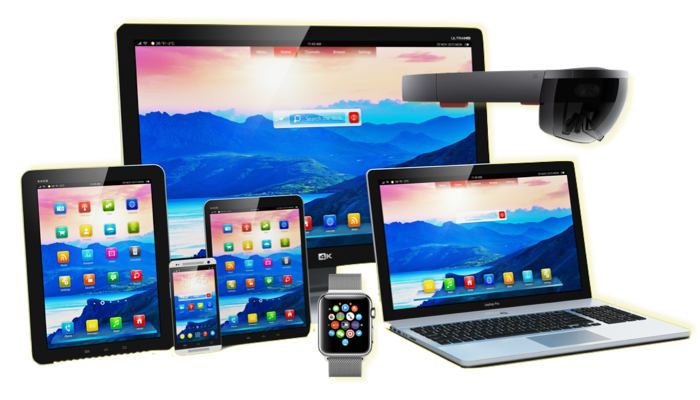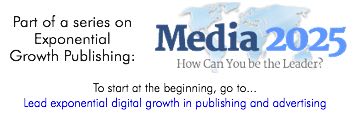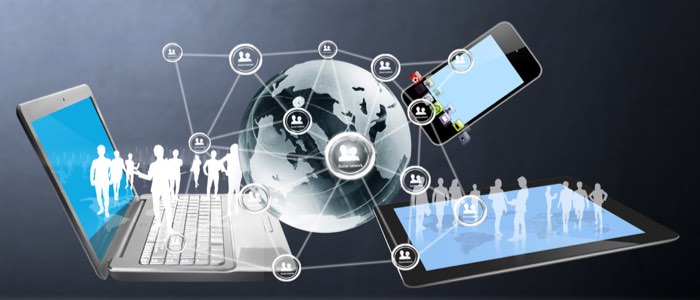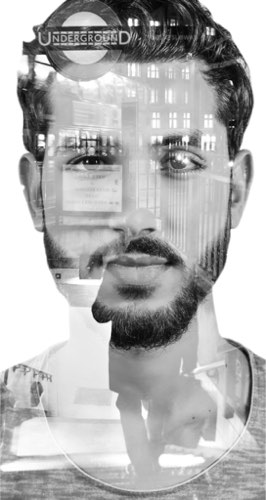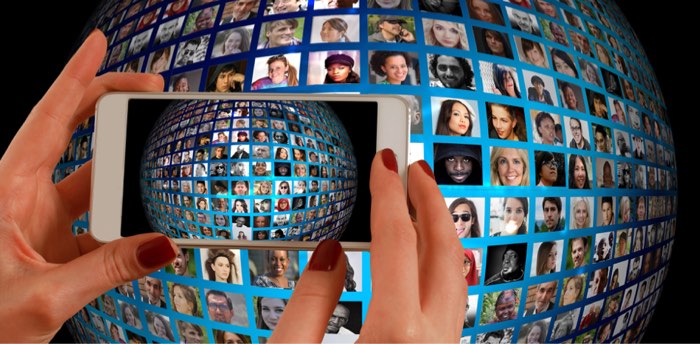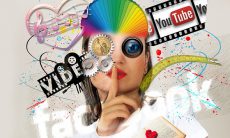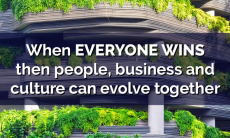Lesson for leaders
Today’s devices limit their users to what the designers and their apps enable. Every vendor has a roadmap that maintains control over its users. Customers are taken to a corporate-first future where vendors run the world and capture its wealth.
The giant platforms want to control everything, everywhere, all the time.
Publishers have lost advertising revenues, content displays, and leadership. But what if they use exponential growth publishing to flip control, put people at the top, and give them the power to run a digital Earth as if it were one device—by using their devices in a new way, as a “family of devices.”
In contrast, these will be continuously connected people. Each user’s needs and wants will decide the unlimited world they live in, no matter which vendor’s devices they use. People do the thinking and decide their futures, with publishers assisting them every step along the way. What happens if publishers develop or partner with services that turn each device into a continuous family that totally serves each user?
There’s been a search for the killer app that will turn augmented reality (AR), virtual reality (VR) and mixed reality (MR) into the dominant interface. It’s here, with more power and value than that. It’s the fast-arriving digital Earth where everyone lives, works, learns, and is entertained.
Publishers will start taking the lead from the vendors of branded devices when they make a “digital Earth as a Service” (DEaaS) part of exponential growth publishing. Forget individual devices and start thinking “families of devices.” This is where and how people could live—at the top, with control over their unlimited lives.
Reality turns digital when devices turn into families
What would the physical world be like if it had to be run digitally?
When a user stands up and looks out a physical window the world is already there, without any need to turn on the outside world, or turn the window off when the user leaves the room. Similarly, when someone goes to a closed door and opens it they can walk through it. The next room is already there, and if a building is exited the outside is already there. There isn’t any need to turn on the new place or any need to turn off the previous place after leaving it.
“Physical reality” isn’t run like an on/off digital device. It is always “present” and “on” and fully interactive whenever we are. We can whirl around to see what’s behind us, dig beneath the ground to see what’s under the surface, or discover a brand new place. There is never any lag time between perceiving and the world around us. We and the world are fully present together, all the time.
A “family of devices” makes “digital reality” work in parallel ways to “physical reality.” The user’s digital reality is continuous and present, but this is produced electronically so that digital reality is automatically maintained, visible, usable, and ready. For example, users do not need to take the steps required by current electronic devices and digital connections. Right now, many devices and apps must be turned on and off. For example, a PC must be booted, then video conferencing software must be loaded before using it to select people to call, and then used to set up and start a video conference. Afterward, when the conference has ended that call or closed that app, the device may be turned off. We hang up after a video conference or phone call.
In contrast, a fully digital Earth includes everyone, with each person at the top, in control of their always-on, continuously connected shared life spaces. How? When you put down a device, it “sees” you’re not using it, turns off, and suspends your shared life spaces. When you turn to your next device, it recognizes you and continues your shared spaces on your new device.
Your screens are blended because you control your digital boundaries. As you flip into each of your shared life spaces, its constructed screens are streamed to (or displayed and voiced by) the device in use (DIU). As you switch devices in a family, your continuous shared spaces move with you, from device to device, from place to place, and from time to time. The user controls the environment and shapes it to where and how they want to “be” digitally.
This digital Earth will be the bridge that brings the blended AR-VR-MR world of tomorrow to today’s devices. If you’re looking for the killer app that gets us into a powerful world that everyone controls and lives in, welcome to the digital Earth’s “family of devices.” It is how we will live, work, learn, and be entertained.
This will start moving exponential growth publishing to the center of everyone’s world, as they start using it to begin living every day across their family of devices.
Filter each person and situation
Let’s take a first step into a digital Earth where each person controls their shared life spaces. What are some of their possible choices?
Imagine being in a digital place and instead of seeing “all” or “everyone,” apply a filter to show only the people and groups you want to see. Each individual and group is visible when selected, and invisible when not selected. For example, a teacher could take a class on a digital visit to New York’s Museum of Natural History. The class would not see anyone there except each other. In another example, you could go to a project team meeting in the shade of the Eiffel Tower in Paris. Only the people from your company need be visible, not the people physically there or other digital visitors from around the world.
By being digital friendly, each destination promotes itself, becoming a must-see when people physically visit it. This is as true for a digital table at a sidewalk cafe on the Champs-Elysees or digital lounge chairs on the roof of a tourist boat as it sails on the Seine.
There are many reasons to be in a digital place and choose to filter it for a select group of people. More examples include:
- Life: Any shared life space with two or more people digitally present, such as the equivalent of a Facebook conversation, private page, or group.
- Entertainment: A live digital event that charges admission such as a ticketed concert at Madison Square Garden.
- Work: A company’s employees who attend their CEO’s visual all-hands meeting over the company’s private network.
- Education: The teacher, students, and parent chaperones on class digital field trips to explore special places and their histories, like the Great Wall of China or Egypt’s pyramids, without passports and without time-consuming flights.
This is a more human world than today’s social media. Everyone can experience personal relationships in each situation, place, time, and activity. Interruptions can reduced. The experience is more personal than the usual public place and ad-filled commercial journey. This digital world is focused on what each person wants and on the ways they want to live.
Constructed realities: co-creating the digital Earth wanted
Some options in exponential growth publishing add more freedom than representing digital places on a user’s “family of devices.” This includes new ways to live with digital powers that give people control over the economy. If digital boundaries are included, this replaces advertising and content with the user’s preferred products and vendors. If connected consumption is added, the products and services needed to live in each type of reality are delivered where and when each person needs them. If active knowledge is used, embedded guidance helps users reach immediate successes, which can start universal prosperity that includes everyone.
Some examples of “constructed realities” include:
- Art and music: Streaming music evolves into soundtracks for living, working, and enjoying life. Personally responsive realities auto-stream your favorite music and art to enhance your activities and feelings.
- Mother Nature: Restored, natural, and healthy ecosystems surround you, with appropriate products delivered by connected consumption, and active knowledge guidance to help develop that world.
- Renewable energy only: Digital boundaries and connected consumption replace fossil fuel choices that are renewable across your screens. By living this way, millions of daily choices slow climate change and help save the Earth.
- Health, fitness, and beauty: Reshape your health and lifestyle with active living, nutritious eating, and fun clothes.
- Events for audiences and participation: Planetary “what’s hot now” takes you to the world’s best live entertainment every minute; like participate digitally in sunrise yoga on the beach in the Seychelles, cook with one of the world’s great chefs, and celebrate Carnaval in Rio.
Each “constructed reality” adds new ways to transform the world one vision at a time. Just as blogs let individuals add new writings to publishing, and YouTube let people add new videos to media, new “constructed realities” will let anyone add new realities to the world.
On the construction side, many devices will be powerful enough to create these. Cloud services can add features like digital boundaries, connected consumption, and active knowledge. On the broadcasting side, multiple “finished realities” can be rebroadcast by an exponential growth publishing platform. On the receiving side these are interactive streamed sources. They can be enjoyed as an interactive digital background or by flipping between them. These new ranges of digital realities may make the world more interesting, entertaining, or meaningful than ever before.
Reality replacement businesses: Your money or your life?
Are we locked into today’s separate devices? Or will families of devices enable a universal digital Earth? The Web and cloud services show two of the ways that “digital” operates worldwide, independent of every uniquely branded device and its ecosystem.
When constructed digital realities are created and published, some could grow very popular. In areas that have people living well, working productively, are healthy and raising great kids, each constructed reality can support these millions who reach for its flavors of success and happiness.
The most popular digital realities, with large audiences and connected consumption, will be the most attractive for those who want to monetize all or parts of this “family of devices.” Their publishers will be connected minute-by-minute with the people who use their filters and realities. The combination of large audiences and interactive behavior generates huge value that is normally monetized:
- Bigger audiences earn publishers more money.
- Digital boundaries increase the revenue by responding to user instructions and replacing advertising and content with what is wanted in each constructed reality.
- Connected consumption adds transaction fees and “online store” revenues. It closes the gap between consumers and their preferred vendors.
- Reality becomes the glue between them publishers and audiences while locking out competing companies.
Some of the biggest competitors include the algorithm-run giant platforms from Facebook, Google, Amazon, and others. These giant platforms use corporate-first technology. They track each person, herding everyone to their commercial reality. Their advertising and promotions use people’s personal profiles to focus each person on their must-have brands and purchases. They stoke personal anxieties to motivate people to pay attention and buy what they sell. They turn people into targets, driving them down marketing routes filled with sales pitches. Every journey includes buying decisions and ends in a store. Persuasive incentives are everywhere, attempting to convince people about what they should look at, do, and know.
This destination is far worse than it seems. The platforms’ commercial world algorithms organize the world’s people, herding them through a constructed commercial reality they don’t own or control. Today’s platform world is presented as if it is the only world in which we should live and pitched as the only life we should want.
But little is real in their world. During the nanosecond that each person acts, their attention is sold in a programmatic auction, like the highest bidder for each head of cattle. Then the user’s screen is dynamically constructed with the winner’s pitches displayed.
The best personal messages are retrieved and delivered during the moment of action. The best manipulators make the most money and use those revenues to win the most auctions. This Darwinian competition builds an economy powered by herding everyone personally. Could these giant platforms switch to people-first?
Maybe, but their revenues depend on persuading people to live as mass-market commercial targets. New technologies like digital boundaries that switch control over the interface to people and people-first constructed realities may prove difficult for them. Like many technology platforms before them, today’s giant platforms may be another VHS or 8-track model that is left behind. Who is hungriest to replace them?
The industries that are being killed have smart managers and resources to kick-start their leadership. Two examples are publishers being executed by Facebook and Google, and mass-market retailers being eliminated by Amazon. If threatened industries start using people-first exponential growth, and cloud-services to spread rapidly, they could obsolete the giant platforms.
The rise to prosperity
Here’s one way to turn around platform-triggered declines. Flip reality to people-first. The creators of constructed realities can redesign the realities that they and others want in many new ways. Exponential growth publishers can broadcast these new realities for mass use. Audiences can try any they like and live in the versions of reality they prefer. Many of them can be free to stream and use, because using them produces the monetization that supports them.
Monetization revenues can be shared:
- Reality creators deserve a share.
- So do cloud services that add features like digital boundaries, connected consumption, and active knowledge.
- Then there are the publishers and media who distribute them in pursuit of exponential growth.
- Most importantly, users grow their wealth immediately, as each reality adds different kinds of benefits and abilities, many without financial costs.
This is the purest type of productivity growth: increasing its users’ outputs rapidly at zero or low costs. Productivity drives the economy’s growth but this time its benefits are people-first, not corporate-first. Together, a growing range of people receive the immeasurable new abilities and growth from new digital realities. Instead of taking generations, everyone can grow their achievements in just a few years, increasing everyone’s personal satisfaction and prosperity today.
But these are business and economic reasons. Is there a new kind of dawn everyone can experience?
The people-first digital Earth on your family of devices
What does it mean when each person can choose and switch between the constructed realities they enjoy?
Users receive new ways to shatter the glass ceiling between who they are and what they aspire to become. Creators bring the world they desire to digital life. When published, large numbers can live the digital lives they would like:
- Creation: Families of devices become creation tools for developing, producing, and living constructed digital realities. These device families make these the users’ continuous realities as they move from device to device, place to place, and time to time.
- Production: Cloud services can take the constructed realities and add monetization features like digital boundaries, connected consumption, and active knowledge.
- Broadcasting: Publishers can deliver multiple digital realities as cloud services at low cost.
- Life: People can receive and try multiple realities until they experience the ones that raise them. Then they can make these their realities, and flip between them to fit each activity and situation.
- Leading companies: Connected consumption redirects companies to become people-first preferred vendors. They increase their accuracy, efficiency, and profitability by making what users consume as they live in the ways they want. This redirects economic production to a people-first economy that is named partnership capitalism.
- Achievement: Active knowledge helps users achieve their new goals directly.
This flips the world from corporate-first platforms where “nothing is real except what motivates each targeted person to buy,” to people-first realities where everyone thinks for themselves and decides what they want their life to be.
Instead of today’s systems that limit people and keep them from their dreams, families of devices enable breakaways that envision both people’s dreams and new ways to take the journeys that reach them.
Today’s physical reality controls people and shuts down most hopes. But now, people can develop or choose the realities they want.
Families of devices change bits at the speed of computers and spread them across all our devices. This turns the slow physical world into a digital Earth. That changes the world into what people want to live and become.
With exponential growth publishing you could deliver a new family of devices mantra: if you don’t like your reality, change it.
Disclaimer: All articles in Media 2025 are provided as-is for general information. Only the issued patent, such as U.S. Patent 9,183,560 “Reality Alternate,” and patent pending application and specification, describe patented and patent pending technology.
Related articles in Media 2025:
- First article — Executive Summary: Lead exponential digital growth through publishing and advertising
- Previous article: Take back advertising revenues: digital boundaries can serve millions and earn billions
- Next article: Switch the user interface to accelerate growth and leadership

